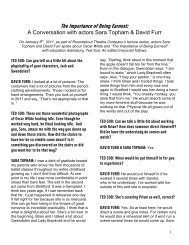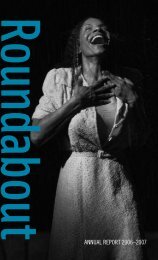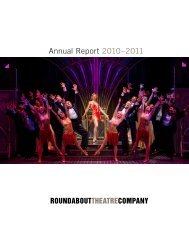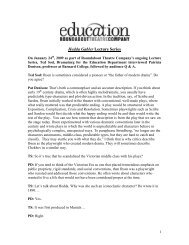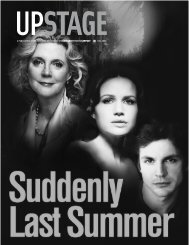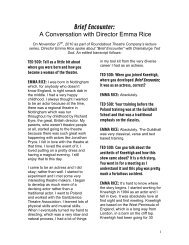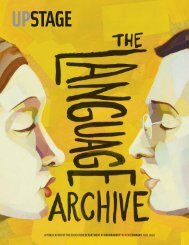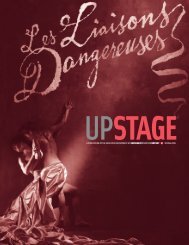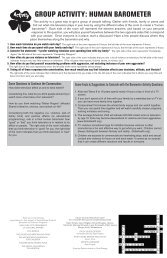The Language of Trees - Roundabout Theatre Company
The Language of Trees - Roundabout Theatre Company
The Language of Trees - Roundabout Theatre Company
Create successful ePaper yourself
Turn your PDF publications into a flip-book with our unique Google optimized e-Paper software.
Interview with the Set Designer:<br />
Cameron Anderson<br />
“I always start each process by<br />
finding images that tell the<br />
metaphorical story”<br />
tree that reveals itself for the first time in that moment<br />
when the tree lights up.<br />
When you say the set wraps around the audience,<br />
does that mean the action will happen all around<br />
the audience or is it contained?<br />
Tell us a bit about the challenges <strong>of</strong> designing this<br />
play <strong>The</strong> <strong>Language</strong> <strong>of</strong> <strong>Trees</strong>, and how you went about<br />
dealing with those challenges.<br />
<strong>The</strong> main challenge <strong>of</strong> designing this play is really the<br />
size and shape <strong>of</strong> the theatre. It’s very small and has an<br />
unconventional amount <strong>of</strong> space and the play is so vast<br />
in its imagery and calls for really evocative magical<br />
events. <strong>The</strong> play is filled with wonderful visual images<br />
that are a dream for me to encounter because I love<br />
figuring out how to resolve those challenges in<br />
transformative ways. <strong>The</strong> difficultly is that when you’re<br />
in a really intimate theatre and the audience is very<br />
close to the tricks that your trying to use, you have to<br />
come up with solutions that work in different ways than<br />
they would in a big proscenium theatre. Here you have<br />
to be very honest about everything. We’ve reoriented<br />
the theatre in a different configuration than it was used<br />
for Speech and Debate. We’ve created this wonderful<br />
wrapping around <strong>of</strong> the scenery so the audience is<br />
really surrounded on all sides by the set. We took the<br />
image <strong>of</strong> the tree and the sand and we’ve combined<br />
those two images to create a metaphorical through line.<br />
It’s a little bit <strong>of</strong> both. People are not swirling around<br />
the audience. It’s sort <strong>of</strong> 180 degrees not 360 degrees.<br />
We’re also trying to integrate the existing elements <strong>of</strong><br />
the theatre, so that when you come in, you really feel<br />
like you are immersed in the environment. It’s a way to<br />
embrace the intimacy.<br />
Can you tell us how the play has relevance for you?<br />
It is a beautiful play that is relevant to everyone because<br />
it’s about the Iraq war. In that way it’s political, but it’s<br />
not written in a way that’s overtly political. Its really a<br />
story <strong>of</strong> loss and how you one day wake up and have<br />
something happen to you that is the worst thing you<br />
could ever imagine and how you pick up the pieces.<br />
Do you want to tell us about how the specific images<br />
actually work?<br />
I always start each process by finding images that tell<br />
the metaphorical story. And they might be images that<br />
end up having nothing to do with the play. <strong>The</strong>y may not<br />
be images <strong>of</strong> Iraq or <strong>of</strong> a kitchen, but for this play,<br />
they’re images that tell a story <strong>of</strong> something beautiful<br />
and disturbing at the same time. I had an image <strong>of</strong> sand<br />
falling in a translucent tree in my mind when I read the<br />
play the first time; an image <strong>of</strong> beauty and suffocation;<br />
an image <strong>of</strong> a glass tree slowly filling up with sand;<br />
which supports the idea <strong>of</strong> Iraq and all <strong>of</strong> the imagery <strong>of</strong><br />
sand in your mouth -- and the stifling <strong>of</strong> emotion that<br />
happens when tragic things happen to people. <strong>The</strong><br />
translucent tree murmurs and speaks and then lights<br />
up in this very magical way and splits with its<br />
magnificent light. <strong>The</strong> sand falling is a part <strong>of</strong> the<br />
murmuring and there’s a crystalline wall behind the<br />
(Natalie Gold, Gio Perez, and Maggie Burke)<br />
It’s about how humans have the extraordinary ability to<br />
move on in the face <strong>of</strong> terrible tragedy. It’s about<br />
family, so it’s very moving to me. It’s something anyone<br />
will be moved by whether you are for or against the Iraq<br />
war because it’s about loss and that’s something that<br />
anybody can connect to.<br />
Could you tell us how you came to be a designer and<br />
any advice you would give to students in middle or<br />
high school who would like to do the type <strong>of</strong> work<br />
you are doing.<br />
UPSTAGE FALL 2008 <strong>The</strong> <strong>Language</strong> <strong>of</strong> <strong>Trees</strong><br />
7



